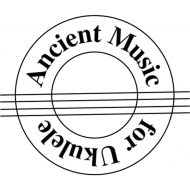Selection of Music for this Book
All the pieces in this book were written for the Renaissance guitar and were included in 9 surviving books published by Adrian Le Roy and Guillaume Morlaye:
Premier livre de tabulature de guiterre (1551) — Cinquiesme livre de guiterre en tabulature (1554)
Premier livre en tabulature de guiterne (1552) — Quatriesme livre en tabulature de guiterne (1552)
Some of the pieces have already been arranged and included in the following books from Ancient Music for Ukulele:
- Favourites of Le Roy on the Ukulele (Books 1 and 2)
- Favourites of Morlaye on the Ukulele (Books 1 and 2)
Notes on the Composers and Pieces
All sources are Wikipedia.
The name branle (or bransle) derives from the French verb branler (to shake, wave, sway, wag, wobble) and is a type of French dance popular from the early 16th century to the present. The term also refers to the music and the characteristic step of the dance. The branle was danced by a chain of dancers, usually in couples, with linked arms or holding hands. The dance alternated a number of larger sideways steps to the left (often four) with the same number of smaller steps to the right so that the chain moved gradually to the left.
NOTE: When the pieces in the original books do not have a secondary name, they have been assigned numbering for convenience (e.g. I, II, III, …).
Adrian Le Roy (c.1520–1598) became an accomplished musician and entered the service of, first, Claude de Clermont, then, Jacques II (Baron de Semblançay and Viscount of Tours), both members of the aristocracy who had influence at court. Le Roy and his cousin Robert Ballard founded the printing firm “Le Roy & Ballard”, and in August 1551 obtained a royal privilege from Henry II to print music. Royal patronage was a major factor in the company’s success since it ensured both a ready supply of new music from the court musicians and a market for its publications. Over the following two decades other rival companies dropped out of the market and from the 1570s onwards Le Roy & Ballard enjoyed a virtual monopoly in music publishing. Le Roy achieved renown as a composer and arranger of songs and instrumentals, his published work including at least six books of tablature for the lute, five volumes for the guitar and arrangements for the cittern. Le Roy’s book L’Instruction pour la mandore gives modern historians hints as to the instrument’s origins and design.
- All of the bransles in Premier livre de tabulature de guiterre (1551), are in “Le Roy Favorites on the Ukulele (Book 1)” from Ancient Music for Ukulele.
- The bransles in this book of arrangements can be found in Second livre de tabulature de guiterre (1555) and Tiers livre de tabulature de guiterre (1552). Where there are gaps in the numbering, the pieces are in in “Le Roy Favorites on the Ukulele (Book 2)” from Ancient Music for Ukulele.
Guillaume Morlaye (ca 1510 – 1558) was a French Renaissance era lutenist, composer and music publisher. He was a pupil of Albert de Rippe and lived and worked in Paris. In 1552 he received a ten-year license to publish music from Henry II, and between 1553 and 1558 published four lute collections in cooperation with Michel Fezandat and six lute collections compiled by Albert de Rippe. He also published three books of his own four-course Renaissance guitar compositions during 1552–53, including fantasies and dances, and also lute arrangements of Pierre Certon and Claudin de Sermisy. Besides his music publishing activities, Morlaye was reported to have engaged in the slave trade, although reliable evidence for this is scant.
- Most of the bransles in Le premier livre en tabulature de guiterne (1552), are in “Morlaye Favorites on the Ukulele (Book 1)” from Ancient Music for Ukulele.
- Most branles in this book of arrangements can be found in Second livre en tabulature de guiterne (1553) and Quatriesme livre en tabulature de guiterne (1552). Where there are gaps in the numbering, the pieces are in in “Morlaye Favorites on the Ukulele (Book 2)” from Ancient Music for Ukulele.
